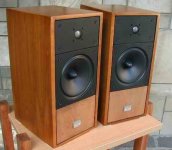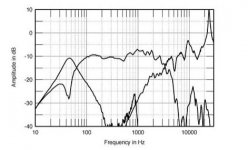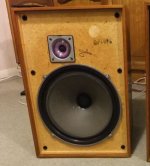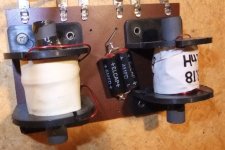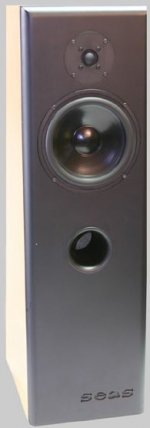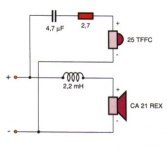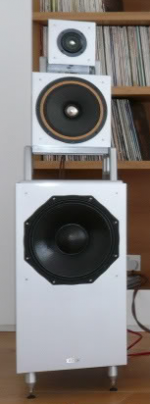Not LS3/5A (?)
When the effect of diffraction is so obvious, it is hard for me to accept the "primitive" baffle. Troel himself seems to prefer Wilson Audio approach (ATS ==> Alexia) these days.
Which particular effect of diffraction are you thinking of?
Why do you think Troels might prefer the Alexia-style configuration to the square box monitor? Lots of sharp angles on both.
Alex
Which particular effect of diffraction are you thinking of?
Rectangular, sharp edge (non-minimal) baffle.
Why do you think Troels might prefer the Alexia-style configuration to the square box monitor? Lots of sharp angles on both.
Just guessing. Linkwitz uses rectangular baffle on the Orion. After the Pluto, then the LX521 which is the improved Orion uses non-rectangular baffle.
Troel's designs in the past have been sharp rectangular baffles. His newer best designs uses minimal prismatic baffle (which is a simplified curved baffle in essence).
When we have experienced working with such a low diffraction baffle, and when construction is not an issue, it is hard not to continue working with such baffle. At least with big radius rounded corner.
Rectangular, sharp edge (non-minimal) baffle.
Just guessing. Linkwitz uses rectangular baffle on the Orion. After the Pluto, then the LX521 which is the improved Orion uses non-rectangular baffle.
Troel's designs in the past have been sharp rectangular baffles. His newer best designs uses minimal prismatic baffle (which is a simplified curved baffle in essence).
When we have experienced working with such a low diffraction baffle, and when construction is not an issue, it is hard not to continue working with such baffle. At least with big radius rounded corner.
I suspect that a lot of the motivation behind the "prismatic" baffle designs (whether Troels, Wilson, Avalon or whoever) is aesthetic, as much as acoustic. Some customers/builders like these because they look attractive in an expensive way, even when they do have sharp, straight edges. I have read that you need something like a 3cm radius curved edge to eliminate the ripples in the frequency response at high frequencies from edge diffraction, whereas placing the drivers off-centre helps considerably, for much less effort and expense.
I personally dislike the term "low diffraction", since the diffraction step will happen whatever the shape of your baffle, with the exception of wall mounted drivers.
Besides, the latest of Troels's Classics (the Discovery and the SEAS Mk 2, with the stepped baffles) are actually quite recent designs - the SEAS in particular appeared as recently as last year. He told me that the asymmetric driver placement on the Classics was the result of a fair amount of trial and error.
Alex
Last edited:
I suspect that a lot of the motivation behind the "prismatic" baffle designs (whether Troels, Wilson, Avalon or whoever) is aesthetic, as much as acoustic.
Aesthetically I prefer BBC style. Pyramid is the best balance between aesthetic and acoustic to me.
I personally dislike the term "low diffraction", since the diffraction step will happen whatever the shape of your baffle, with the exception of wall mounted drivers.
Yes. Don't know who used that term originally. We can use "smooth diffraction" now
Besides, the latest of Troels's Classics (the Discovery and the SEAS Mk 2, with the stepped baffles) are actually quite recent designs - the SEAS in particular appeared as recently as last year.
It started out with the word "Classics" which also represented the enclosure style I believe. Troel didn't even expect that it would be built by many. Recent design (Mk something) is only logical consequences. It is not easy (not possible actually) to design a PRETTY stand-mounted speaker with non-rectangular shape. That stepped baffle on the classic is awesome.
He told me that the asymmetric driver placement on the Classics was the result of a fair amount of trial and error.
Trial and error?? It is a proven approach and I have used it since a long time ago. Enclosure adjustment is normal after having the prototype and the crossover set.
AR speakers always looked a bit thrown together and ugly too.
I never understood why they brought the tweeter connections out to the front baffle, then covered them in goop or tape.
KEF did the same thing for a while, they even had the circuit board for the crossover on the outside of the baffle on some models, with wires running out the port tube.
An externally hosted image should be here but it was not working when we last tested it.
Aesthetically I prefer BBC style. Pyramid is the best balance between aesthetic and acoustic to me.
I have been thinking a lot about sloping baffles recently, in my journey to understand the shortcomings of my original three-way design. This has a separate box for mid and treble in the shape of a truncated pyramid. The trouble with a sloping baffle is that, although it is a good approach to time-aligning the acoustic centres of mid and treble drivers, the treble you hear at the listening position is off axis, which means that the room sound contains more high frequencies relative to the on-axis response than if you were listening on the tweeter axis. I don't know what the consequence of this is, but my prejudice is that a smooth decay of the response of axis is preferable.
Actually I think this is one crucial advantage of the Wilson et al approach using separate boxes for each driver - you can use each driver on axis,while being able to situate each at the optimum distance from your ears.
It started out with the word "Classics" which also represented the enclosure style I believe. Troel didn't even expect that it would be built by many. Recent design (Mk something) is only logical consequences. It is not easy (not possible actually) to design a PRETTY stand-mounted speaker with non-rectangular shape. That stepped baffle on the classic is awesome.
I think we are close to complete agreement on this.
As it happens, this thread is of great interest to me, since I am in the process of building the SEAS Classic Mk2.
Trial and error?? It is a proven approach and I have used it since a long time ago. Enclosure adjustment is normal after having the prototype and the crossover set.
Surely the logical approach is to build a box to suit the drivers, then tweak the crossover to adjust for the diffraction from the box shape?
Alex
Last edited:
I have been thinking a lot about sloping baffles recently,
in my journey to understand the shortcomings of my original
three-way design.
Alex
Hi Alex,
why don't you start a new thread and see if anyone can
help to sort it out. Have you got any measurement setup?
Hi Alex,
why don't you start a new thread and see if anyone can
help to sort it out. Have you got any measurement setup?
Funnily enough: Measuring my three-ways…
Alex
Indeed. So, how did you set the driver polarities?
Three-way LR4 has all drivers in the same polarity.
Alex
It depends on the crossover. If two drivers are time-aligned at the crossover frequency, an odd-order L-R or Butterworth filter will make the drivers 90 degrees out of phase, so either normal or inverted polarity will work. A second-order filter (Troels's 3-Way Classics with the stepped baffle, for example) will require one of the drivers (normally the midrange in a three-way) to be wired with inverted polarity, while an LR4 filter like the ones I used in my previous design crosses all the drivers with the same polarity.
Alex
Alex
Ah, interesting as these phase and polarity discussions are, the muse of classic speakers takes us onto those weird two way designs with next to no crossover at all. 
The Dynaco A25, the Devore Orangutan, the SEAS A26. And a few oldies and oddities.
You need a biggish bass for a steep natural mechanical rolloff. Then you struggle for a tweeter that can crossover low or just go for a natural 3kHz with 8" bass. Enter Robin Marshall's Epos ES14. I don't know what Robin is up to these days, but he was a deep thinker on dispersion and dynamics and driver integration and even cone materials and shape.
The Epos had a crossoverless polycone bass and a single cap and maybe some resistance to the metal tweeter. My old 12" paper bass Wharfedale Melton 2 had some of this sort of sound. And the SEAS Njord is along the same lines. It's a very good sound on percussion and drums IMO. People like it and it harks back to the sort of speakers people listened to back in the valve days. Mellow, in a word. Maybe a more modern modelled approach would use a series filter.
The Dynaco A25, the Devore Orangutan, the SEAS A26. And a few oldies and oddities.
You need a biggish bass for a steep natural mechanical rolloff. Then you struggle for a tweeter that can crossover low or just go for a natural 3kHz with 8" bass. Enter Robin Marshall's Epos ES14. I don't know what Robin is up to these days, but he was a deep thinker on dispersion and dynamics and driver integration and even cone materials and shape.
The Epos had a crossoverless polycone bass and a single cap and maybe some resistance to the metal tweeter. My old 12" paper bass Wharfedale Melton 2 had some of this sort of sound. And the SEAS Njord is along the same lines. It's a very good sound on percussion and drums IMO. People like it and it harks back to the sort of speakers people listened to back in the valve days. Mellow, in a word. Maybe a more modern modelled approach would use a series filter.
Attachments
The trouble with a sloping baffle is that, although it is a good approach to time-aligning the acoustic centres of mid and treble drivers, the treble you hear at the listening position is off axis,
True. Though I don't like speakers that doesn't sound good off-axis (on-axis is less important for me).
But pyramid means also minimum baffle for HF drivers. Just like Vandersteens and even the Alexia. So a combination of stepped baffle and pyramid.
My last speaker was inspired by this (see attachment): Art Impressions
Actually I think this is one crucial advantage of the Wilson et al approach using separate boxes for each driver - you can use each driver on axis,while being able to situate each at the optimum distance from your ears.
Also easy if you want to roll-off any of the drivers. Especially if you want to experiment with various waveguide ideas.
As it happens, this thread is of great interest to me, since I am in the process of building the SEAS Classic Mk2.
Dare to try rounded corners?
Surely the logical approach is to build a box to suit the drivers, then tweak the crossover to adjust for the diffraction from the box shape?
If your intention is true LR2 from the beginning, you may start with the stepped baffle, but often decision changes on the fly.
If box is decided from the beginning, diffraction should be measured/simulated with box dimension and be used in the modeling of the crossover.
Attachments
Without a crossover schematic and some remarks about driver choice, you are a bit short on detail there, Jay. 
Actually, I found more interest in Troels' big baffle Poor Man's Strad. It "comes with a room" acoustically. And the room power response must be flatter.
This thread's topic is classic monitors. And I enjoy going down memory lane to the great designers. Robin Marshall designed about half of the great UK sellers of the 1980s and 1990s along with the above Epos ES14. I often wondered what he thinks about it all now. Still as interesting as ever, actually.
An interview with Robin Marshall, ex-Epos designer - AudioEnz
Actually, I found more interest in Troels' big baffle Poor Man's Strad. It "comes with a room" acoustically. And the room power response must be flatter.
This thread's topic is classic monitors. And I enjoy going down memory lane to the great designers. Robin Marshall designed about half of the great UK sellers of the 1980s and 1990s along with the above Epos ES14. I often wondered what he thinks about it all now. Still as interesting as ever, actually.
An interview with Robin Marshall, ex-Epos designer, ca 2007
Michael Jones: Interview made last year by the student audio club at the university in Hong Kong. I nicked this from the Pink Fish forum.
Q – You are probably best known as the founder of Epos and for the products you designed under the Epos badge.
Is that right? Epos engaged a rather short period in my life. I’ve done other things, too.
Q – Nevertheless, people still talk about the ES14 and the various audio forums are full of posts relating to them. I’ve seen them favourably compared with the best current products on several occasions.
(Laughs) That’s very flattering. It’s always nice to have one’s ego massaged.
Q – Were you involved with any of the Epos products that came after the ES11 and ES14?
Not at all.
Q – Do you take any interest in the current direction and product offerings of Epos?
To be perfectly honest, I don’t know a thing about what goes on at Epos these days. It simply isn’t my concern. I’ve known Mike Creek, who owns Epos, for many years and I have every confidence that he is making stuff that’s right for today’s market.
Q – Do you still use Epos speakers in your own system?
No, I’ve not used them for many years.
Q – What do you use?
I have several different speakers which I use in different parts of the house. I do quite a lot of informal listening sitting in front of my computer and for this I use small nearfield monitors which I cobbled together using odds and ends that I had lying around. In my main system I usually use a JBL 1400 Array, although I sometimes pull out an old pair of Yamaha NS1000.
Q – Are these better than your Epos designs?
Off course. If nothing else, the JBL Array has the capability to handle the dynamics available from today’s recordings.
Q – If you were back at Epos and making a speaker in the category of the ES14, would you do it differently from the original?
I designed the ES14s more than 25 years ago and things have moved on since then. Recorded music has a more bandwidth, greater dynamic range and less distortion. Reproduction systems obviously need to keep up. We have access to better materials and manufacturing technology and we have computational power that was just a dream when I was working on the ES14.
Physics hasn’t changed, of course, and all the constraints that were in place when I designed the ES14 are still there. What has changed is our ability to negotiate within these constraints and fine tune the various conflicting trade-offs. Finite element analysis, for example, would have reduced the time I spent designing the ES14 magnet system by a considerable margin and would have enabled me to do a much better job. As it was, I had to rely largely on intuition and cut-and-try evaluation. Most of the design calculations were made using a Hewlett-Packard HP41 programmable calculator and took an eternity. Today it would take just a few minutes.
My views and my engineering prejudices haven’t changed much in 25 years, but the tools available to me certainly have. I’d like to think that I could design better products today than I could yesterday.
Q – Would you use a metal dome tweeter?
(Laughs) I’m an old man and I don’t hear much above a 500 Hz any more so I’d probably leave the tweeter out.
Q – Seriously, you have often championed metal dome tweeters in the past. Are you still convinced of their merits?
All tweeters are defective in one way or another. I’m not so much a fan of metal for tweeter domes as a fan of high-modulus materials. It just happens that most of the available high-modulus materials are metals.
It seems to me to be important to avoid destructive resonances in the diaphragms of high frequency driver units if we are to have any hope of extended bandwidth and predictable dispersion characteristics. Most soft domes tweeters exhibit seriously resonant behaviour and the best we can do is to damp the Q of these resonances. Maybe that’s an acceptable solution. Maybe it’s not. All I can say is that I would prefer not to have the resonances in the first place.
I looked very seriously at beryllium when I was designing the ES14 tweeter, but I had to accept that it simply wasn’t possible to manufacture Beryllium domes without the risk of killing myself and anyone else who came into the factory. Times have changed and now I could buy ready-made beryllium domes from China for half what it cost me to make aluminium ones. Using beryllium for the dome wouldn’t be a panacea, but it would certainly give me a bit of a leg-up.
Q – Minimalist crossovers is another of your hallmarks. Would an updated ES14 follow this path?
Simple crossovers place huge demands on the drive units and in almost every respect are more difficult to engineer properly than complex ones. In a perfect world I would use first order electro-mechanical slopes because nothing else can equal their time and frequency domain performance. Lots of things need to be right to make them work and it certainly isn’t a trivial engineering exercise. It’s the fastest route I know to exposing all the deficiencies you built into your drive units!
First order electrical slopes designed in isolation of the responses inherent to the drive units are not the same thing as first order electro-mechanical slopes, as I sure you know, and may or may not provide the same performance benefits.
High order crossovers make the designer’s life easy and on the face of things allow the use of less-than-perfect drive units. I’m not convinced that they don’t add their own set of defects to the mix, however. I’m always amused when I see products with fourth order networks described as “phase coherent”. I assume that they respond to physical laws which are different from the ones that I know.
Q – The ES14 is often criticised for its bass. Do you think with hindsight that you got it wrong?
One big problem with the ES14 was that people refused to use it in the way I intended. They always wanted to believe that it was a vented box, which it wasn’t. It could certainly be seriously boomy and ill-controlled when used as one. I’ll have to leave it to your judgement to say whether I got it wrong.
Something that I might say in my defence if you decide that I did get it wrong is that much has changed in the world since I designed the ES14 and it shouldn’t really be a surprise to find deficiencies when it is exposed to today’s higher resolution program material. I certainly wouldn’t expect to step out of my current car and into one made quarter of a century ago without having to make some adjustments to my driving and to my expectations.
More important than all that is the fact that you cannot consider the low-frequency performance of a speaker in isolation. You need to consider it as part of an integrated system with the room. The room is always the dominant factor at low frequencies unless it is large enough to have resonant modes outside the bandwidth of the speaker. Any speaker with reasonably extended bass is likely to get itself into trouble in the average room and there will always be a chance of it sounding fantastic in one room and dire in another.
The best thing is probably to equalise the speaker/room system. I use four sub-woofers in my main system to try to energise the room modes coherently and I use a parametric equaliser to notch the major additive room resonances. One great thing at low frequencies is that if you take care of the frequency domain you automatically take care of the time domain.
Q – Would you have any interest in designing a product like the ES14 but updated for today’s technology?
Not really. I don’t have an awful lot of interest in hi-fi these days and have very little knowledge of today’s flavours. My attention is tuned more to professional audio.
Q – I’ve read somewhere that you had something of a reputation for the sheer scale and diversity of your recorded music collection. Is music still important to you?
Absolutely. Nothing has changed. I still see my application of technology as being nothing more than a servant of the music. How does it sound is still the most important question that I can ask myself.
Q – Is your music collection on vinyl or CD?
A mixture of both. It’s increasingly finding its way onto hard disk, too.
Q – I know that you once played your vinyl on a Linn LP12 but that you no longer do so. That came as a surprise to me because I thought that the LP12 was something of a legend. What turntable do you use now?
I owned an LP12 for several years but I became increasingly frustrated by its performance limitations. I think its true to say that the LP12’s reputation was build on a foundation of ******** and I guess that the myth promised us more than the reality was able to deliver. I returned to a Garrard 401 which I’ve owned for at least a million years. I’m sure that the sophistication of today’s precision engineering tools could produce something better, but I’ve simply not taken the time to look around at what is currently on offer.
Q – And Naim Audio?
I’m still a big fan of the Naim products that I use in my own systems. I have one of their CD players and I have several NAP250 power amplifiers. The NAP250 is a good, solid product, even if its circuitry is not far removed from an application notes design. I’ve always thought that Naim take a lot of care to get the fundamentals right and this shows in the reliability and continuity of their products.
I’ve not shut my eyes to other manufacturers by any means. I’ve owned a raft of different amplifiers over the years and I still have a liking for tube amplifiers. This dates back to my schoolboy days when I spent all my money at H L Smith’s in the Edgware Road buying kits to build the various Mullard designs.
Q – How would you categorize yourself? Are you a physicist? An audio engineer? A product designer? What?
It would be pretentious to call myself any of these things. I’m a seeker of knowledge. With each successive year I learn a little more and then find that I know even less than I previously thought. On the day that I die I shall probably need to confess that this amazing reverse spiral has resulted in my not knowing anything at all.
AudioEnz publisher and your host.
An interview with Robin Marshall, ex-Epos designer - AudioEnz
Last edited:
Ah, interesting as these phase and polarity discussions are, the muse of classic speakers takes us onto those weird two way designs with next to no crossover at all.
The Dynaco A25, the Devore Orangutan, the SEAS A26. And a few oldies and oddities.
You need a biggish bass for a steep natural mechanical rolloff. Then you struggle for a tweeter that can crossover low or just go for a natural 3kHz with 8" bass. Enter Robin Marshall's Epos ES14. I don't know what Robin is up to these days, but he was a deep thinker on dispersion and dynamics and driver integration and even cone materials and shape.
The Epos had a crossoverless polycone bass and a single cap and maybe some resistance to the metal tweeter. My old 12" paper bass Wharfedale Melton 2 had some of this sort of sound. And the SEAS Njord is along the same lines. It's a very good sound on percussion and drums IMO. People like it and it harks back to the sort of speakers people listened to back in the valve days. Mellow, in a word. Maybe a more modern modelled approach would use a series filter.
I always had mixed feelings about the ES14 when I heard it at shows in the 1990s. I liked the liveliness and the natural sound, but I wasn't impressed by the treble, which always sounded a little "obvious" to me. I assumed at the time that this was the metal dome tweeter, but it could have been that I just didn't like Naim amplification…
Alex
True. Though I don't like speakers that doesn't sound good off-axis (on-axis is less important for me).
In the absence of a true omnidirectional speaker, my ideal is to listen on axis and have a smooth decay off axis, independent of frequency.
Dare to try rounded corners?
Bevelled edges, rather than Troels's square ones. I'm not that brave. Besides, I think rounded edges would look odd with the stepped baffle, which I now understand has to be left just as it is.
Alex
Actually, I found more interest in Troels' big baffle Poor Man's Strad. It "comes with a room" acoustically. And the room power response must be flatter.
I don't have room that big.
In the absence of a true omnidirectional speaker, my ideal is to listen on axis and have a smooth decay off axis, independent of frequency.
I think I have never listened on axis. I prefer the sound to be best from where I sleep or work
- Home
- Loudspeakers
- Multi-Way
- Classic monitor designs?
